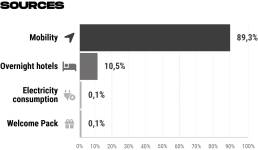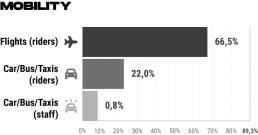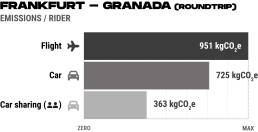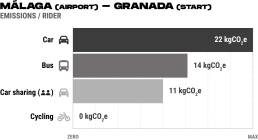CYCLING EVENTS CARBON FOOTPRINT
"IF YOU CANNOT MEASURE IT, YOU CANNOT IMPROVE IT"W.T. Kelvin
Cycling and sustainability. They seem two concepts that come together, but how much affect the circumstances behind that riding moment? From Badlands Rewild we ask ourselves what is the real environmental impact of organising events like this.
SCOPE
The first question that comes to our mind are the terms or units in which we measure this environmental impact. The second, which factors will be considered.
The answer to both questions is the Greenhouse Gas Protocol (GHGP). This standard covers the accounting of seven greenhouse gases covered by the Kyoto Protocol emissions in terms of tCO2 equivalents. For this purpose the GHGP divides emissions into 3 scopes: direct emissions, electricity indirect emissions and other indirect emissions.
This Carbon Footprint (CF) calculation allows us to: 1.Be aware of our environmental impact, 2.Take action to reduce emissions, 3.Try to offset unavoidable emissions and 4.Raise awareness among all people involved.

Badlands Rewild has made very exhaustive calculations of the emission sources, considering among others: Welcome Pack CF, energy consumption in accreditation, or the use of PCs, hotel overnights and mobility considering riders and staff.
As expected, given the nature of an international cycling event with almost no infrastructure due to its unsupported spirit, the main source of emissions is mobility.
A second important source of emission is the hotel overnights of the riders and staff before, during and after the event. However, the impact of electricity consumption as well as the Welcome Pack CF have not had a significant impact on the final result.


RESULTS
The final result is a Carbon Footprint of 194 tCO2e, that is, approximately 0,6 tCO2e/rider.
Is this so much? As a reference, the World Bank estimates an average annual emissions per capita of 4,5 tCO2e, being almost double in Europe and triple in the US. It is considered that this data should be around 1 tCO2e to stabilize global warming.
Following to understand the scale of this data, these 194 tCO2e are equivalent to the CF generated by the annual consumption of about 42 houses in Spain.
In terms of mobility, the riders’ transport by plane means 66% of total emissions. The transfer by car 21% and the rest of transports (staff and media team) 2%. The rest of the emissions are mainly due to the overnights in hotels by riders (9%) and staff (1%).
ACTIONS
The first actions that this kind of events could take is exactly these audits: measure -to locate sources- and communicate -to raise awareness among stakeholders-.
But of course there are also small acts that can get some impact on the global CF. For example, delivering cotton t-shirts instead of polyester for the 300 Welcome Packs has reduced the CF in about 150 kgCO2e.
However, as mentioned before, all those actions related to mobility will have the greatest impact on the CF: organising shared private vehicles for the stakeholders and informing about public transport could reduce it considerably.
Despite all the actions we can carry out, there will always be an inherent and unavoidable footprint. This is where compensation mechanisms come into play and the organisation must be involved.

CONCLUSIONS
Although those 600 kgCO2/rider seems like a lot, the actual footprint of each participant will depend largely on the way taken to join the event.
In order to offset all those unavoidable emissions, the organisations should offer compensation mechanisms such as reforesting, although the riders could also consider other kind of initiatives in their own community.
However, although in this post only the CF has been considered as a measure of sustainability, other factors such as a correct waste policy during the event is critical.
A sustainable event not only reduces negative impacts on the environment but must also be able to leave a positive legacy in the community that hosts it from an environmental, social and economic point of view.
The organisation of a sustainable event represents an act of consistency with ethical values, as well as responsibility towards planet and people.
Read more about our environmental and social initiatives in Badlands Rewild.
Contact us to info@badlands.cc to join our next Reforestation Camp. Places are very limited.
Sources:
GHG Protocol / Climate Change Committee / Ecoterrae / World Bank Group






